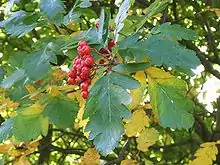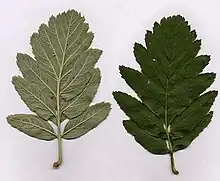Hedlundia hybrida
Hedlundia hybrida, the oakleaf mountain ash,[2] Swedish service-tree[3] or Finnish whitebeam, is a species of whitebeam[1] native to Norway, eastern Sweden, south-western Finland, and locally in Latvia.[4][5][6]
| Hedlundia hybrida | |
|---|---|
 | |
| Foliage and fruit | |
| Scientific classification | |
| Kingdom: | Plantae |
| Clade: | Tracheophytes |
| Clade: | Angiosperms |
| Clade: | Eudicots |
| Clade: | Rosids |
| Order: | Rosales |
| Family: | Rosaceae |
| Genus: | Hedlundia |
| Species: | H. hybrida |
| Binomial name | |
| Hedlundia hybrida (L.) Sennikov & Kurtto | |
| Synonyms[1] | |
|
List
| |
Description

Hedlundia hybrida is a medium-sized deciduous tree growing to 10–15 m tall with a stout trunk up to 60 cm in diameter, and grey bark. The crown is columnar or conic in young trees, becoming rounded with age, with branches angled upwards. The leaves are green above, and densely hairy with white hairs beneath. 7–12 cm long and 5–8 cm broad, the leaves are lobed, with six to nine oval lobes on each side of the leaf. These lobes are broadest near the base with the two basal pairs of lobes cut right to the midrib as separate leaflets, rounded at the apex, with finely serrated margins. The autumn colour is dull rusty brown. The flowers are 20 mm in diameter, with five white petals and 20 yellowish-white stamens; they are produced in corymbs 6–11 cm in diameter in late spring. The fruit is a globose pome 12–15 mm in diameter, bright red, maturing in mid-autumn. The fruit is succulent, and eaten by thrushes and waxwings, which disperse the seeds.[4][6]
Taxonomy
It is a tetraploid species of hybrid origin between the European rowan (Sorbus aucuparia) and the Swedish whitebeam (Scandosorbus intermedia),[5] the latter being a tetraploid triple hybrid between S. aucuparia, the wild service tree (Torminalis glaberrima), and the common whitebeam (Aria edulis) or one of its close relatives.[7][8] S. intermedia differs from H. hybrida in having the leaves less deeply lobed with no separate leaflets. Closely related Hedlundia meinichii is a triploid or tetraploid species of hybrid origin between H. hybrida and S. aucuparia[9][10] and differs in having the basal four to six pairs of lobes cut right to the midrib as separate leaflets. All three polyploid species are apomictic species which breed true without pollination.[4]
Cultivation
Hedlundia hybrida is grown as an ornamental tree in northern Europe, and is locally naturalised in the British Isles.[4] The cultivar 'Gibbsii' has gained the Royal Horticultural Society's Award of Garden Merit.[11][12]
References
- "Hedlundia hybrida (L.) Sennikov & Kurtto | Plants of the World Online | Kew Science". Plants of the World Online. Retrieved 2023-09-23.
- USDA, NRCS (n.d.). "Sorbus hybrida". The PLANTS Database (plants.usda.gov). Greensboro, North Carolina: National Plant Data Team. Retrieved 24 November 2015.
- BSBI List 2007 (xls). Botanical Society of Britain and Ireland. Archived from the original (xls) on 2015-06-26. Retrieved 2014-10-17.
- Rushforth, K. (1999). Trees of Britain and Europe. Collins ISBN 0-00-220013-9.
- Den Virtuella Floran: Sorbus hybrida (in Swedish; with maps)
- Vedel, H., & Lange, J. (1960). Trees and Bushes in Wood and Hedgerow. Metheun & Co. Ltd., London.
- Nelson-Jones, E.B.; Briggs, D.; Smith, A.G. (2002). "The origin of intermediate species of the genus Sorbus". Theoretical and Applied Genetics. 105 (6–7): 953–963. doi:10.1007/s00122-002-0957-6. PMID 12582921. S2CID 21448997.
- Chester, M.; Cowan, R.S.; Fay, M.F.; Rich, T.C.G. (2007). "Parentage of endemic Sorbus L. (Rosaceae) species in the British Isles: evidence from plastid DNA". Botanical Journal of the Linnean Society. 154 (3): 291–304. doi:10.1111/j.1095-8339.2007.00669.x.
- Bolstad, A. & Salvesen, P. (1999). "Biosystematic studies of Sorbus meinichii (Rosaceae) at Moster, S. Norway". Nordic Journal of Botany. 19 (5): 547–559. doi:10.1111/j.1756-1051.1999.tb01138.x.
- Liljefors, A. (1953). "Studies on propagation, embryology, and pollination in Sorbus". Acta Horti Bergiani. 16: 277–329.
- "RHS Plant Selector - Sorbus × hybrida 'Gibbsii'". Retrieved 5 March 2021.
- "AGM Plants - Ornamental" (PDF). Royal Horticultural Society. July 2017. p. 98. Retrieved 15 November 2018.